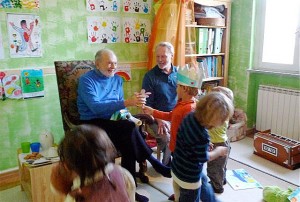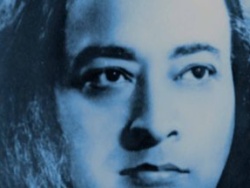 Education for Life (EFL) is the system of education depicted in the film that emphasizes joyful learning and individualized, student-centered education.
Education for Life (EFL) is the system of education depicted in the film that emphasizes joyful learning and individualized, student-centered education.
Helen Purcell is director of an EFL school, Living Wisdom School, located in Palo Alto, California.
Q: The first Living Wisdom School was started in 1971, in the rural environment of Ananda Village. As director of a Living Wisdom School in a major metro area, do you find you’re able to serve a more diverse population?
Helen: The first question many parents ask is how we can accommodate our very diverse student body. On the spiritual side, we have children from Hindu, Muslim, Buddhist, Muslim, and Christian families. We’re also diverse in race – we have Asian, Hispanic, Native American, African American, and Caucasian children. And finally, we have children from broadly diverse economic backgrounds.
But the demographics of our students aren’t actually a concern, because our approach to children levels the playing field. We’re acutely aware of the individuality of each child, regardless of their background. We’ve demonstrated that if you honor the individual child, including those who are academically gifted, wonderful things can happen.
We’re deeply aware that our first task with each child is to love them, see them for who they are, and encompass them in an energy of acceptance, support, and love. This approach cuts across demographic fences, and it’s firmly embedded in a school culture of kindness and compassion. As a result, we’ve seen tremendous growth among the children, often bordering on the miraculous.
Here in Silicon Valley, many families are highly intelligent, and strongly motivated toward performance. When we tell parents that our first consideration is to love the child, there’s often a disconnect for them, because it’s so far outside their own experience. Everything they know tells them that a successful school is one that enables the children to get A’s on their report cards and be accepted by a prestigious high school.
Q: Spending time in the middle school classroom, I saw many examples of individual attention and kindness. How does a system that’s based on loving the children work for them academically?
Helen: When you find yourself in an atmosphere of acceptance and support, it frees you to become better. It’s not just for the students who need help meeting the academic norms. We’ve had our share of students that we might call prodigies, and they aren’t free of issues. They may have no problems meeting our academic standards, but there’s almost always some factor that’s preventing them from being as successful and happy as they could be.
I’m thinking of a student who took advanced calculus in eighth grade. In terms of his intelligence, he was obviously in a class by himself. In fact, we had two exceptional middle school students in math that year, and we had teachers who could challenge and help them. However, that boy needed to learn that he wasn’t the center of the universe. When he arrived, he was very abrasive, because he was so mentally quick, and he’d been used to receiving a ton of special attention. He had to learn to value others who weren’t capable of doing math at his level.
In his four years with us, he became a charming young man, and it was all because of Gary, our middle school teacher, who took an approach that I think was brilliant.
Among other things, Gary encouraged this boy to tutor the other students who needed help, and it ended up humanizing him. The other students loved having a peer that they could go to with questions. And it didn’t affect his academic performance; in fact, it energized him, because he discovered a sense of belonging and being valued at a human level for his teaching skills and compassion.
When I had him in my language arts class, his skills were amazing. His rough drafts were often final drafts that only needed minor polishing. He had an amazing, high-energy mind, but Gary taught him to laugh and discover how his intelligence could help him succeed in the context of his life and his search for fulfillment and happiness.
I ran into his mother recently, and she told me he’s doing extremely well at one of the Bay Area’s most prestigious high schools. She laughed because she said she has trouble keeping up with him. He’s written a commercial computer program that he started working on in eighth grade, and he’s acquired investors and has a start-up in the works.
Thanks to the remarkable gene pool in Silicon Valley, we have amazing children like this boy, and our curriculum serves them very well, because we’re able to challenge them at their level. But our curriculum is about far more than academics. It’s about the whole person, and learning to bring your whole self to everything you do.
We had a girl who was very, very adept academically. After fifth grade, she announced that she wanted to transfer to a public middle school. We said, “Why would you want to do that?” I thought it was the wrong decision for her, and so did Gary. But her mother said, “I have to let her follow her path.”
She told Gary she wanted to be in a big school with lots of kids, and a swimming pool and tennis courts. Gary said, “But you don’t play tennis or swim.” She said, “I know, but I just want that.”
So off she went, and in May her mother called and asked if her daughter could return.
I said, “Great, I’ll put her on the list for next year.” But the mother said, “I don’t mean next year. She wants to come back right now.”
I said, “But it’s May, and school will be out in three or four weeks.”
She said, “Helen, she can’t stay there.”
So she came back, and she had lost some of her spark. It took her six months into the following year to come back to her genuine, enthusiastic former self.
She told us that she’d been placed in a class where the teacher was very rigid. She was capable of so much more than the teacher was asking, and she was very much more personally expansive. But the teacher was wedded to the state-mandated curriculum which says that on such-and-such day everyone will be working on such-and-such page of the book. So they locked horns, and the teacher heaped a ton of negative energy on her.
She was miserable, because it was all about the rules. And it’s not that we don’t have structure and rules, but we’re eager to do whatever it takes to help the individual child succeed and be happy, both personally and academically.
Q: The image strikes me that if you’re training only the intellect, it’s like trying to work as a carpenter without arms. When you’re doing academics, you can’t avoid bringing feeling and will and energy, and your hopes and dreams to it, and not only your reasoning faculties. I sense that you believe modern public education can be harmful if it lobotomizes these other faculties, cutting them off and telling the student to repress them.
Helen: Oh, yes. We had another little girl who was highly, highly intelligent, but she came from a school where she’d been severely bullied, and there was a part of her that was so closed down and tight that she could barely breathe.
During her three years in our environment we saw a remarkable transformation. It culminated in her graduation speech, where she described how she used to be afraid of everything. “And now,” she said, “I am not afraid of anything. I can stand up and talk to any group, no matter how big, and I can ask them questions. I can move through life.” She said, “I am ready for high school.”
Children who’ve been badly bullied are like the children of alcoholics. They desperately need to control their universe because it’s so dangerous and unpredictable. At Living Wisdom School she found supportive teachers and peers who helped her relax and feel accepted and safe so that she could learn. Today, she’s traveling all over the state as part of her high school’s debate team.
You want children to rise to their potential – you don’t want to confine them to somebody’s rigid standards, which are nearly always set too low.
Q: The assumption in education today seems to be that by focusing on the mind, it’s more efficient to transmit academic knowledge. Gary McSweeney, the middle school teacher at LWS, explained how it’s actually much more efficient if you engage the child, which means that you have to work with their hearts and who they are. Observing in Gary’s class, I saw how enthusiastic the children were for what they were doing, and it seemed far more efficient than the typical public school classroom where the students are reluctant and the teacher’s energy is absorbed in prodding them to learn and preventing them from getting out of control. In Gary’s class they were engaged and they weren’t trying to escape the situation.
Helen: Exactly. If you had come to a language arts class where we were doing Shakespeare, you’d have seen that we don’t simply read Shakespeare. We do reader’s theater, where they’re acting out the parts in Elizabethan English. If they don’t know the meanings of all the words, nobody cares, nor do we care if they mispronounce a word. We’re not there for perfection. We’re there for the enjoyment of something that’s terribly worthwhile and wonderful. By the time we’ve finished a play, even the students who had never read Elizabethan English are completely jazzed, because it’s a classroom culture of celebration and learning.
Then I take them to a professional performance where they can see real actors living the play magically. Some of them become perceptive theater critics, because they feel a personal connection and expertise, from acting the play. “This actor was really good, but that one could have done her character better because….” It’s marvelous – just imagine, these are 11- through 14-years-olds, and they’re thoroughly engaged with Shakespeare.
One recent student was deeply involved with drama. We went to see Taming of the Shrew, in a performance that was skewed toward a feminist perspective, and she picked up on it right away. She said, “I don’t think a male director could have done this.” This is a 13-year-old. She wrote a marvelous analysis of the direction of the play.
It could never happen in a culture that requires the students to plow through the book mechanically and “study to the test.” It’s possible because there is such freedom to be who you are. This girl was so excited about drama, and when she asked if she could write a critical review of the direction, I said, “Of course.” Another student might ask to write something completely different, and if it’s creative and expansive, I would encourage it. It’s very far from the “efficient” curriculum of standardized, flatly uniform assignments and testing.
Q: That’s a huge step – writing papers at that level. It’s exactly the training they need for college, much less high school.
Helen: Yes, it is. My goal for the eighth graders in writing is not only that they know how to put together a nice expository essay, but that it has their personal creative engagement, solid content, and a nice, readable flow. So I’m looking for things that I didn’t learn until I was in college. And when we’re talking about style and tone, it often comes naturally, because they’ve had a personal experience of the energy and beauty of the play before they start to develop their analytical papers.
Their research papers for history and science are very real. Sometimes they’re based on a combination of a class lecture, reading, and a field trip. When they’re studying Native American cultures, for example, they might visit a Miwok Indian village. During our annual school play, a huge, all-school production that’s based on an inspiring historical figure, they study the history and culture of the times. After the production, they write reflections on their experience, and they often reference their academic knowledge in describing their personal growth.
Learn more about Education for Life and the Palo Alto Living Wisdom School.









